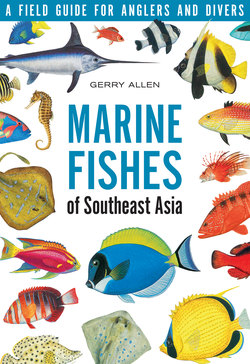Читать книгу Marine Fishes of South-East Asia - Gerry Allen - Страница 14
На сайте Литреса книга снята с продажи.
ОглавлениеCLASSIFICATION OF
FISHES
Although the fundamentals of biological nomenclature and classification are common knowledge to many, it is my experience that the average non-biologist frequently has little idea of the basis of scientific names or how fishes are classified. It therefore seems worthwhile to include a brief section on the rudiments of this subject.
Every described organism, be it a single-celled amoeba, crab, bird, fish or mammal has a scientific or Latin name. It is composed of two parts and is generally italicised. The first part is the genus or generic name and the second is the species or specific name. For example the Five-lined Seaperch is Lutjanus quinquelineatus. The generic name Lutjanus pertains to a group of closely related species which share a number of common features related to general shape, scalation, type of teeth, fin-ray counts, etc. The specific name quinquelineatus applies only to a single entity that is distinguished from its relatives by a unique set of characteristics, often including colour pattern. Related genera (plural of genus) are grouped together in a family, whose spelling always ends in - idae. An illustrated list of families is presented on pages 9-18. Worldwide there are about 450 families - more than 300 are represented in Australia and surrounding regions. A group of similar families is placed in one of the 35 orders of fishes whose spelling always ends in -iformes. The highest rungs on the ‘ladder’ of classification pertain to class and phylum. The class Myxini contains the jawless hagfishes and lampreys (no species included in this book); Chondrichthyes contains sharks and rays; and the third class Osteichthyes contains the majority of fishes. All fishes, as do other higher animals including amphibians, reptiles, birds and mammals, belong to the phylum chordata. Therefore, in summary the classification of the Five-lined Seaperch can be represented as follows.
Phylum - Chordata (all animals with notochord)
Class - Osteichthyes (all bony fishes)
Order - Perciformes (most reef fishes)
Family - Lutjanidae (seaperches and relatives)
Genus - Lutjanus (closely related seaperches)
Species - quinquelineatus (5-lined seaperch)
Characters that are most often used to separate species, and often genera, include external features such as the number of fin rays, size and number of scales, ratio of various body proportions, and colour pattern. For higher classification at levels above genus internal structure, particularly those pertaining to skeletal elements, are often indicative of relationships.
Many species previously unknown to science have been found in our region over the past few decades. When a new fish is discovered it is given a scientific name by the researcher who formally publishes a detailed description in a recognised scientific journal. Scientific names are frequently descriptive. For example quinquelineatus is Latin for five lines and is therefore appropriate for the Fivelined Seaperch (see Pl. 42-7 in species section). New fishes are sometimes named after the locality from where they are collected, for example japonicus (Japan) or novaeguineae (New Guinea). A third category of specific names are based on the names of people, often the person who first discovers the fish (respectable researchers never name fishes after themselves). Fishes named after a male end in - i, those after females in - ae.
